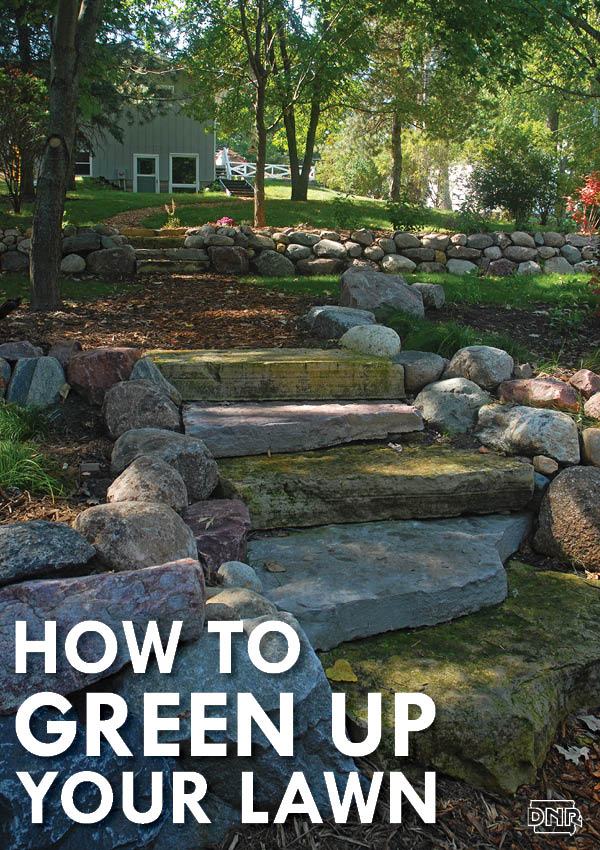From the July/August 2008 issue of Iowa Outdoors magazine
Climate change, greenhouse gases, carbon footprints, water quality— the problems are huge and the impact we can deliver seems minimal. But, you can do something simple—cut back on yardwork. Most people don’t think about the carbon footprint left by their lawns and lawn care. Green is green, right?
However, if you add it all up, America’s 31.6 million acres of turf have a big impact. Lawn care for an individual household can add up to one-third of the water bill during summer months. That water takes energy to pump and treat—costing about $4 billion and using 56 billion kilowatt-hours of electricity per year on a nationwide scale. Fuel, fertilizer and carbon emissions all have their costs to the environment, too. But we can make a difference, one yard at a time. Simple changes in your management style and landscaping can save more than money. Use these tips to save energy, time, greenhouse gas emissions and water.

10 Cost-free Tips
1. Set your mower high to leave two to 3.5 inches of grass blade. Cut no more than one-third of the grass blade at a time to increase plant health and retain moisture.
2. Let lawns go dormant during the hottest weeks of summer. Most turf grasses will survive more than a month without water.
3. If you must have green grass, water during the early morning (most preferable time to prevent disease problems) or evening to reduce evaporation.
4. Sprinklers put water on sidewalks, streets or lose spray to the air. Use drip hoses or soak systems to place water where it’s needed to cut water use up to 50 percent.
5. Don’t over water. Add rainfall and watering together by setting up a rain gauge or an open tin can. Most lawns need about one inch of water per week, so only water enough to make up for lack of rainfall.
6. Use alarm clocks, kitchen timers, outdoor water timers or rain sensors to make sure you turn the water off.
7. Water deeply and slowly. Give water time to soak into the soil to promote deep roots and healthy plants. You’ll prevent water pollution, too, by keeping nutrients in your yard, not in runoff.
8. Take advantage of rainfall by directing downspouts into shrubs and gardens, and away from your foundation.
9. Minimize fertilizer (often made using natural gas) use, particularly in dry years. Heavily fertilized turf uses more water and can actually stress plants during a drought. That dark green color is actually a sign of over-fertilization – a healthy lawn is a medium green color. The most important time to fertilize is during the fall, so plants go into winter with strong root systems and extra food supplies. Use a slow release product and apply it during dry spells.
10. If washing your car at home, park it on the lawn to take advantage of the runoff and keep pollutants from storm sewers. Or use a commercial car wash, where the rinse water is collected and treated.
10 Low-cost Tips
1. Use mulch around plants and in gardens to reduce evaporation and keep weeds at bay.
2. Add compost, cow manure, peat or other organic matter to increase your soil’s capacity to absorb water and add nutrients.
3. Start a compost pile to decompose yard wastes instead of sending them to a city facility. Tutorial: Learn How to Compost at Home
4. Add composted leaves and grass clippings to the top layer of your lawn to provide organic matter and soil nutrients.
5. Consider replacing annuals with native ecotype perennials for low maintenance and lower water requirements. Generally, native plants will perform better and require less water, fertilizer, and pest or disease management because they have adapted to local conditions over thousands of years.
7 Native, Easy to Care For Plants for Your Yard
6. Consider downsizing large expanses of lawn, replacing turf grass with native plants that also attract birds and butterflies. You’ll reduce time and gas used for mowing, while decreasing maintenance and costs for fertilizer and pesticides.
7. As you plan garden areas, put plants with the same moisture requirements in groupings so you can water according to their needs.
8. Use a mulching lawn mower to cut down on mowing time and carbon emissions while adding organic matter and fertilizer to your lawn.
9. Consider an electric mower to reduce air and noise pollution. Or, in a small yard, a modern push mower can limit greenhouse gas emissions while providing a calorie-cutting workout.
10. Check garden hoses and hose fittings for leaks. Fix leaks and replace washers in the hose ends. Just 12 drops per minute can add up to 52 gallons per month or 631 gallons per year. This can save you money inside your house, too.
3 higher cost tips to reduce carbon footprints
1. Select native tree species and plant them to shade other plantings, reducing heat stress and water losses. Properly placed and selected, they can shade your house in summer and protect it from winter winds, saving energy.
2. Consider adding rain barrels to collect rainwater that drains from your roof. Modern systems have lids, and can easily be added to downspouts, storing water on-site until you need it.
3. If you are considering collecting and reusing gray water (untreated water used in showers, sinks and clothes washers) in your yard, research the system and economics carefully. Many high tech systems may not be cost effective. However, some effective, newer technologies exist.
Additional Resources: State Forest Nursery (large-scale plantings) Urban tree plantings through Plant Some Shade and Operation ReLeaf
For more ideas on a greener home and lawn, follow us on Twitter and check out our Earth Day Every Day and In Your Own Backyard boards on Pinterest.